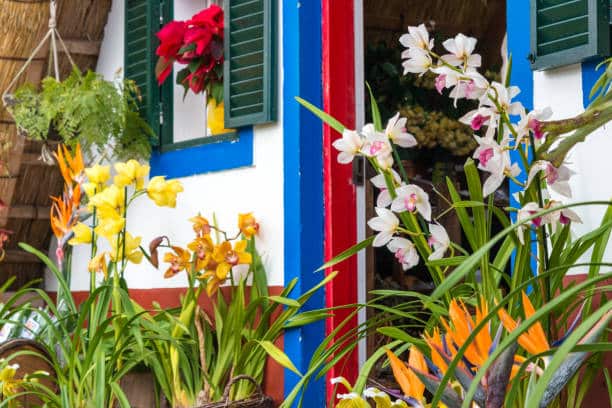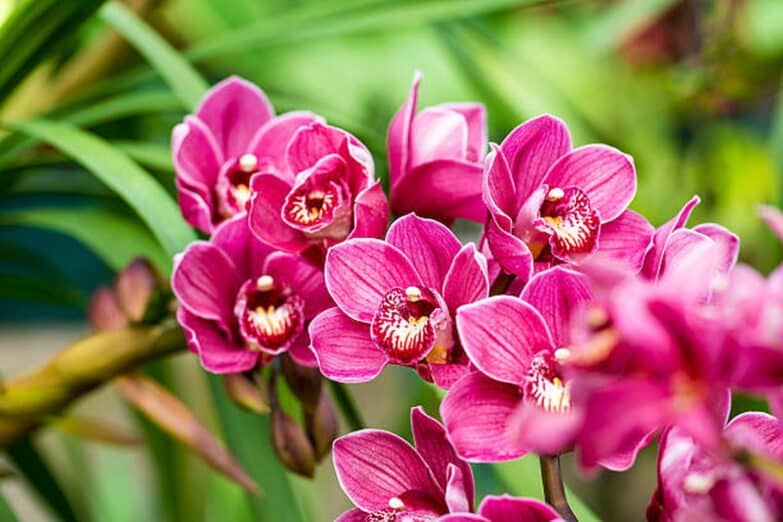Cymbidium orchids, renowned for their stunning flowers and hardy nature, are a favorite among orchid enthusiasts and novice gardeners alike. These elegant plants, native to Asia and Australia, boast a wide range of colors and sizes, making them a versatile and attractive addition to any indoor or outdoor garden. In this ultimate guide to Cymbidium orchids, we will explore the history, varieties, and care requirements, along with propagation and troubleshooting tips. Embark on your Cymbidium conquest and discover the beauty of these majestic orchids!
A Brief History of Cymbidium Orchids
Origins and Cultural Significance
Cymbidium orchids have a rich history dating back thousands of years. They are native to the tropical and subtropical regions of Asia, including the Himalayas, China, Japan, and Southeast Asia, as well as Australia. In traditional Chinese culture, Cymbidium orchids are highly valued for their delicate beauty and are often associated with virtue and morality. These orchids have been cultivated for centuries in China and Japan, where they are frequently featured in paintings, poetry, and other forms of art.
Taxonomy and Etymology
The genus Cymbidium belongs to the Orchidaceae family and comprises more than 50 species, with countless hybrids and cultivars. The name Cymbidium comes from the Greek word “kymbos,” meaning “boat” or “cavity,” which refers to the shape of the flower’s lip or labellum. Cymbidiums are divided into two main groups: standard Cymbidiums, which are large-flowered and typically grown outdoors, and miniature Cymbidiums, which have smaller flowers and are suitable for indoor cultivation.
Types of Cymbidium Orchids
Standard Cymbidiums
Standard Cymbidiums are known for their large, showy flowers that come in various colors, including white, green, yellow, pink, and red. Some popular standard Cymbidium species and hybrids include:
- Cymbidium erythraeum: This species features ivory or greenish-white flowers with a red-marked lip.
- Cymbidium tracyanum: Recognized by its greenish-brown flowers with a striking white, pink, or red lip, this orchid is highly sought-after for its captivating appearance.
- Cymbidium devonianum: With its unique combination of yellow, green, and brown petals and a contrasting deep red lip, this species stands out in any orchid collection.
Miniature Cymbidiums
Miniature Cymbidiums are prized for their smaller, more compact growth habit, making them ideal for growing indoors or in limited spaces. Some popular miniature Cymbidium species and hybrids include:
- Cymbidium floribundum: This species, also known as the “golden Cymbidium,” boasts a profusion of small, yellow flowers with a reddish-brown lip.
- Cymbidium ensifolium: Recognizable by its slender, grass-like leaves and delicate white, pink, or green flowers, this species is a favorite among miniature Cymbidium enthusiasts.
- Cymbidium goeringii: Also known as the “spring orchid,” this species produces fragrant, greenish-white, or pink flowers with a purple-marked lip.
Cymbidium Orchid Care
Light Requirements
Cymbidium orchids require bright, indirect light to thrive. They can tolerate some direct sunlight, particularly in the early morning or late afternoon, but excessive exposure may cause the leaves to scorch or the flowers to fade. Indoors, placing your Cymbidium near an east or west-facing window is ideal. If growing outdoors, provide dappled sunlight or filtered shade to ensure optimal growth.
Watering and Humidity
Cymbidiums prefer consistent moisture but must not be overwatered, as this can lead to root rot. Allow the top inch of the potting mix to dry out between waterings, and always ensure your pot has drainage holes to prevent standing water. Cymbidiums appreciate higher humidity levels, particularly during their active growing season. To increase humidity, place a tray filled with water and pebbles beneath the pot, ensuring that the pot is elevated above the water level to avoid root rot.
Temperature and Air Circulation
Cymbidiums are more cold-tolerant than many other orchids, making them suitable for outdoor cultivation in temperate climates. They require a temperature drop at night during their blooming season to initiate flower bud development. Ideally, daytime temperatures should be between 65 and 75 degrees Fahrenheit (18 and 24 degrees Celsius), with nighttime temperatures dropping to around 50 degrees Fahrenheit (10 degrees Celsius). Good air circulation is essential for preventing fungal infections and promoting overall plant health, so ensure your Cymbidium has adequate space to grow and breathe.
Potting Mix and Fertilizing
A well-draining, orchid-specific potting mix is crucial for the healthy growth of Cymbidium orchids. Mixes containing bark, perlite, and charcoal are ideal, as they allow for proper drainage and aeration. Fertilize your Cymbidium every two to four weeks during the growing season (spring and summer) with balanced, water-soluble orchid fertilizer. Reduce feeding to once every six to eight weeks during the dormant season (fall and winter).
Repotting Cymbidium Orchids
When to Repot
Cymbidium orchids generally require repotting every two to three years, or when the potting mix has broken down and no longer provides adequate drainage. It is best to repot your Cymbidium in the spring after the plant has finished blooming.
How to Repot
Follow these steps to repot your Cymbidium orchid successfully:
- Gently remove the plant from its pot, taking care not to damage the root system.
- Inspect the roots and trim away any dead or damaged sections using a clean, sharp pair of pruning shears or scissors.
- Choose a new pot that is one size larger than the current pot and has drainage holes. Fill the bottom of the pot with a layer of fresh, well-draining orchid potting mix.
- Place the Cymbidium in the pot, spreading the roots evenly, and fill in around the roots with the potting mix. Ensure that the plant’s pseudobulbs (thick, swollen stems) remain above the soil line to prevent rot.
- Water the newly repotted Cymbidium thoroughly, allowing the excess water to drain away.
Propagating Cymbidium Orchids

Division
The most common method of propagating Cymbidium orchids is through division. To propagate your Cymbidium using this method, follow these steps:
- Carefully remove the parent plant from its pot, gently detaching any roots that may be attached to the pot’s sides.
- Identify the natural divisions between the pseudobulbs, ensuring that each division has at least three healthy pseudobulbs and a portion of the root system.
- Using a clean, sharp pair of pruning shears or scissors, carefully separate the divisions, taking care not to damage the roots or pseudobulbs.
- Repot each division into its own pot filled with fresh, well-draining orchid potting mix. Position the plant so that the pseudobulbs are above the soil line to prevent rot.
- Water the newly potted divisions thoroughly, allowing the excess water to drain away.
Common Cymbidium Orchid Pests and Diseases
Pests
Cymbidium orchids can be susceptible to common orchid pests such as spider mites, aphids, and mealybugs. Regularly inspect your plants for signs of pests and maintain cleanliness by gently wiping the leaves with a damp cloth. If you notice an infestation, treat the plant with insecticidal soap or neem oil, following the manufacturer’s instructions.
Diseases
The most common diseases affecting Cymbidium orchids are root rot and fungal infections, often caused by overwatering or poorly draining potting mix. To prevent these issues, always use a well-draining potting mix and avoid overwatering your plants. If you notice yellowing leaves, wilting, or a foul smell emanating from the soil, your plant may be suffering from root rot. Remove the affected plant from its pot, trim away any rotten roots, and repot it in fresh, well-draining potting mix.
Cymbidium Orchids in Home Décor
Display Ideas
Cymbidium orchids make a striking addition to any home or garden setting. Here are a few ideas for displaying your Cymbidium orchids:
- Windowsill Garden: Arrange a collection of Cymbidium orchids on a bright windowsill for an eye-catching display. Ensure the orchids receive adequate light without scorching their leaves.
- Hanging Baskets: For a unique twist, plant Cymbidium orchids in hanging baskets, allowing their long, arching flower spikes to cascade downward.
- Orchid Centerpiece: Create an elegant table centerpiece by arranging Cymbidium orchid flowers in a shallow dish with water or a decorative vase.
Orchid Arrangements
Cymbidium orchid flowers are long-lasting and make excellent cut flowers for arrangements. Combine Cymbidium flowers with other orchid varieties or complementary foliage for a stunning floral display. Change the water regularly and trim the stems at a 45-degree angle to prolong the flowers’ life.
Conclusion
Cymbidium orchids are a captivating and rewarding addition to any indoor or outdoor garden. With their diverse range of colors and sizes, there is a Cymbidium orchid to suit every taste and space. By providing the proper care and following our ultimate guide, you can embark on your Cymbidium conquest and enjoy the beauty of these majestic orchids for years to come.

